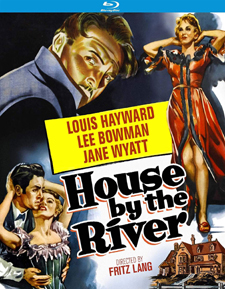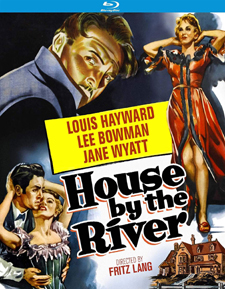House by the River (Blu-ray Review)

Director
Fritz LangRelease Date(s)
1950 (January 14, 2020)Studio(s)
Fidelity Pictures/Republic Pictures (Kino Lorber Studio Classics)- Film/Program Grade: C
- Video Grade: B
- Audio Grade: B
- Extras Grade: B
Review
House by the River from 1950, one of director Fritz Lang’s lesser films, combines gothic melodrama, noir touches, psychological thrills, and a police procedural. Lang made the film for Republic Pictures, a minor studio that attracted major directors with the lure of greater artistic control. Orson Welles’ Macbeth, John Ford’s The Quiet Man, and Nicholas Ray’s Johnny Guitar, all were shot at Republic. Lang had a flop with Secret Beyond the Door two years earlier. Because his stature in Hollywood had suffered and his relationships with movie producers were not ideal, he turned to this low-budget psychological thriller.
The time period is not specified, but judging by the clothes worn by the characters, it is around the turn of the twentieth century. Unsuccessful writer Stephen Byrne (Louis Hayward, Walk a Crooked Mile, The Black Arrow) lives with wife Marjorie (Jane Wyatt, Lost Horizon, Father Knows Best) in a huge mansion on the banks of a river. While his wife is away, he attempts to rape their housemaid, Emily (Dorothy Patrick, The Mighty McGurk, Come to the Stable). She screams. Attempting to silence her, he accidentally strangles her.
Overcome with panic, Stephen convinces his disabled brother, John (Lee Bowman, Cover Girl, Buck Privates), to help him get rid of Emily’s body. Foolishly, John agrees, and in the middle of the night they row the body far out into the river and dump it. The river’s currents, however, wash the body ashore, it’s discovered, and an investigation points to John as the murderer.
Stephen contrives to let his brother take the blame, then draws on his own crime to write a novel that becomes a best selling book. As time passes, Marjorie and John draw closer together, a lengthy trial is held, and Stephen’s guilt and fear of discovery lead to desperate actions.
Even the artistry of a class A director could not save this weak script. We get the idea that older brother John has always, in one way or another, bailed Stephen out when he’s gotten into difficulties, but we don’t know what caused and sustained this pattern of behavior. John’s initial suggestion to go to the police and explain that Emily’s death was an unfortunate accident is vetoed by Stephen, convinced the authorities won’t believe it. In the way he looks at Emily and gazes up at the window of the bathroom where she is showering, we can see that he lusts for her. He attacks her as she descends a darkened staircase, shocking her as much as the audience. When Stephen realizes he has killed Emily, he regards her death as an inconvenience rather than a tragedy.
Lang crafted this highly stylized drama of corruption threatening to triumph over decency with an often hysterical intensity. It contains several elements of film noir but lacks the femme fatale who draws the protagonist into a scheme that proves his undoing. Stephen is his own nemesis. Coincidences, cheap sets, a low-wattage cast, an overwrought performance by Hayward, and a melodramatic script (based on a novel by A.P. Herbert) make this film a fascinating failure.
The new 2K mastered Blu-ray release from Kino Lorber Studio Classics, featuring 1080p resolution, is presented in the aspect ratio of 1.37:1. For a 70-year-old film, the clarity is superb. The print is free of dirt, scratches, and other imperfections and looks pristine. There is a nice range of greys while blacks are rich and lustrous. The long shot of the mansion is a painted backdrop with some lawn furniture and a bit of water in the foreground suggesting the river. Process shots are used when Stephen and John are in the boat dumping Emily’s body and when Stephen and John are tussling on the pier. In both scenes, rear projection creates the illusion of a great expanse of river. The scenes immediately before, during, and after Emily’s murder are deeply shadowed, as Stephen has purposely doused a candle so he can merge into the darkness and be unseen. Marjorie’s scenes, bright and well lit, contrast with Emily’s, which are dark and foreboding. When Stephen takes his boat out to try and retrieve Emily’s body, the reeds near the shore sway, startled birds unexpectedly flutter up, and the body’s elusiveness in the river’s currents combine to create an eerie environment.
The soundtrack is English 2.0 mono DTS-High Definition Master Audio. English subtitles are available for the hearing impaired. Dialogue is clear and distinct. Emily’s screams are loud and piercing as she tries to fend off Stephen’s attack. Director Lang makes good use of silence, particularly when Stephen and John remove the body from the house and row it out into the river. The courtroom sequence contains a great deal of dialogue, as witnesses are questioned and testify. The sound of the water in key scenes adds to the mood and contributes suspense. Unfortunately, in scenes supposedly set right outside the house, there is a slight soundstage echo.
Bonus materials on the Unrated Blu-ray release include an audio commentary, an interview with producer and historian Pierre Rissient, and a set of trailers for other Kino Lorber titles.
Audio Commentary – Film historian Alexandra Heller-Nicholas refers to House by the River as underrated. Action outside the house is all filmed on a soundstage. Considerable discussion centers on the term “seduction” to describe Stephen’s attack on Emily. Heller-Nicholas believes it is an attempted rape and supports her opinion by referring to how Stephen grabs Emily and forces her against the wall. Emily is not Stephen’s equal in power and social class. The Harvey Weinstein accusations and the subsequent rise of the #MeToo movement are discussed. Lang shows sensual images of Emily in the bathroom. Deep shadows are a trademark of both gothic melodrama and film noir. Emily’s dressing gown blends into the wallpaper, suggesting she is—in Stephen’s eyes—a mere part of the furnishings. Marjorie coming downstairs mirrors Emily’s earlier descent but Marjorie stands out, rather than blending into her surroundings. Stephen is haunted by his actions and strives to break free of guilt. The courtroom scene is in the police procedural tradition. Brief biographical overviews are provided for the major cast members. Cinematographer Edward Cronjager received seven Oscar nominations and came from a family heavily involved in the film industry. Fritz Lang fled Germany in 1933 in the face of Nazism. He signed a contract with MGM and from that point on, all of his films were made in the West. Other American films he directed include Ministry of Fear (Ray Milland), Rancho Notorious (Marlene Dietrich), Fury (Spencer Tracy), and Scarlet Street (Edward G. Robinson).
Interview with Pierre Rissient – Filmmaker, producer, and historian Pierre Rissient’s heavy French accent and rapid speech make him difficult to understand. He says he “rescued House by the River from obscurity.” There was not much material about the film because it flopped at the box office. Fritz Lang was not inclined to speak about those of his films that were not commercially successful. House by the River was made right after his previous flop, The Secret Beyond the Door. Rissient tried to track down the film but there was no positive print anywhere. Eventually a fine-grain positive was located. He visited A.P. Herbert, author of the novel on which the film is based, and notes that the river Thames, near Herbert’s home, likely inspired the novelist’s descriptions of the mood of the river. Rissient also compares and contrasts House by the River with other Fritz Lang films.
Trailers – Five theatrical trailers are included: The Woman in the Window, Boomerang, The Spiral Staircase, The Queen of Spades, and The Paradine Case.
– Dennis Seuling

